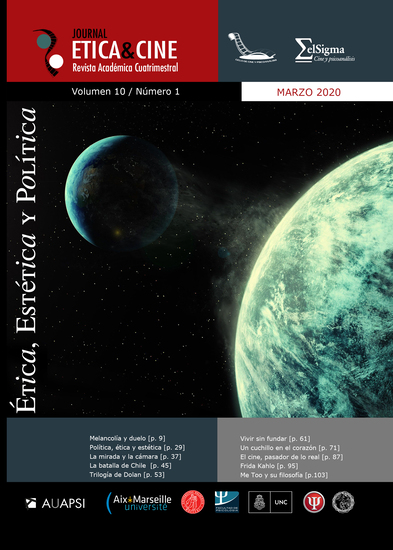Frida Kalho: the look of cinema
DOI:
https://doi.org/10.31056/2250.5415.v10.n1.29224Keywords:
Cinema, Creative process, Psychoanalysis, TraumaAbstract
The film biography titled Frida [2002] produced by the American director and director Julie Taymor, relates the life of the Mexican painter while
being inspired mainly by the book which devoted Hayden Herrera to him. It recounts the tumultuous life of the artist since his young student life,
his accident and his passionate relationship with the muralist Diego Rivera.
Numerous references to Frida Kahlo’s paintings are included in the scenography and recall the richness and complexity of her work: more than one
hundred and forty paintings, of which fifty are self-portraits, which come in different themes: politics, Mexicanism, love, nature, suffering, femininity or even death.
It is from the analysis of a particular scene [which galvanizes the radicality of the abortion test and offers a framework for the expression of the temporality specific to this event, which I qualify as traumatic] that this article, which stands at the crossroads of cinema and psychoanalysis, explains a
decisive stage in the creative process in Frida Kahlo.
Here, the examination of the dialectic between creative process and trauma, allows us to grasp, in the nascent state, the implementation of modes of
pictorial creation which sign a new temporality in his pictorial art.
Beyond that, the challenge of the biopic is to succeed on the one hand in weaving, modeling, staging and images the life of this extraordinary artist;
and on the other hand to allow the spectator to discover the entanglement between the creative subjectivity of the artist and his work.
Downloads
References
Assoun, P.-L. (2004). « La « création » à l’épreuve de la métapsychologie. L’objet inconscient de la création », in Céline
Masson, Psychisme et création, Collection « Perspectives Psychanalytiques ». Paris: L’Esprit du temps. 17-41.
Chouvier, B. (2004). « Processus de création et objets œuvrés », in Céline Masson, Psychisme et création, Collection «Perspectives Psychanalytiques ». Paris, L’Esprit du temps. 67-85.
Crenn, J. (2008). « Frida Kahlo, La chair ouverte ». En Genre & Histoire, 2, 1-11.
Festino-Cassata, R. (2013). Les voies de la mélancolie et de la création chez Chaïm Soutine, le « violeur de couleurs. Radioscopie d’un acte de peinture. Sous la Direction du Professeur Anne Juranville, Thèse de Doctorat en Psychologie Clinique, Université de Nice Sophia-Antipolis.
Gagnebin, M. (1984). L’irreprésentable ou les silences de l’œuvre. Paris: PUF, Collection L’écriture.
Herrera, H. (1983). FRIDA. Une biographie de Frida Kahlo. Paris: Flammarion.
Juranville, A. (2009). "La sensation dans le processus visionnaire de la création chez Virginia Woolf", dans Cliniques Méditerranéennes, 80, 81-95.
Juranville, A. (2017). "Chaïm Soutine. La mélancolie du « dernier peintre maudit". dans La psychanalyse à l’épreuve de l’art. Le féminin, le procès de la création. Saarbrücken. Éditions universitaires européennes, 127-141.
Le journal de Frida Kahlo (1995). Introduction de Carlos Fuentes. Paris: Éditions du Chêne.
Lomas, D. (2001). "Lenguajes corporales : Kahlo y la imaginería médica". En Karen Cordero y Inda Saenz, (compiladoras), Crítica feminista en la teoría e historia del arte, Mexico, 327-343. Recuperado de: https://sentipensaresfem.wordpress.com/2016/09/10/cftha/
Riazuelo-Deschamps, H. (2007). Anthropologie et psychanalyse de la grossesse. Représentations maternelles au cours d’une première et d’une deuxième grossesse. Sous la Direction du Professeur Dominique CUPA, Thèse de Doctorat en Psychologie Clinique, Université de Paris X Nanterre.
Tibol, R. (2007). "Lettres à Alejandro Gómez Arias", dans Frida Kahlo par Frida Kahlo. Paris: Éditions Christian Bourgeois, 58-64.
Downloads
Published
How to Cite
Issue
Section
License
Copyright (c) 2020 Ética y Cine

This work is licensed under a Creative Commons Attribution-ShareAlike 4.0 International License.
Los autores que publiquen en Ética y Cine Journal aceptan las siguientes condiciones:
Los autores/as conservan los derechos de autor © y permiten la publicación a Ética y Cine Journal, bajo licencia CC BY-SA / Reconocimiento - Reconocimiento-CompartirIgual 4.0 Internacional. La adopción de esta licencia permite copiar, redistribuir, comunicar públicamente la obra, reconociendo los créditos de la misma, y construir sobre el material publicado, debiendo otorgar el crédito apropiado a través de un enlace a la licencia e indicando si se realizaron cambios.

Este obra está bajo una licencia de Creative Commons Reconocimiento-CompartirIgual 4.0 Internacional.




